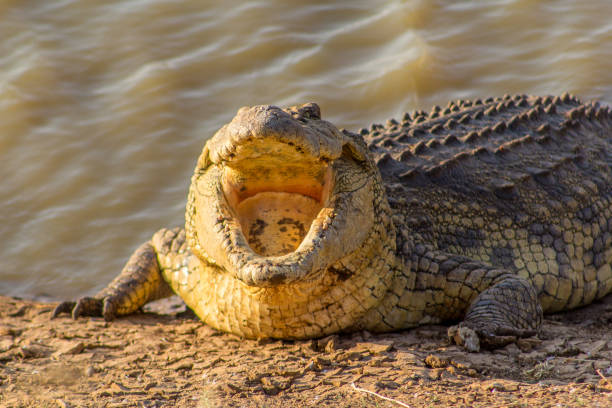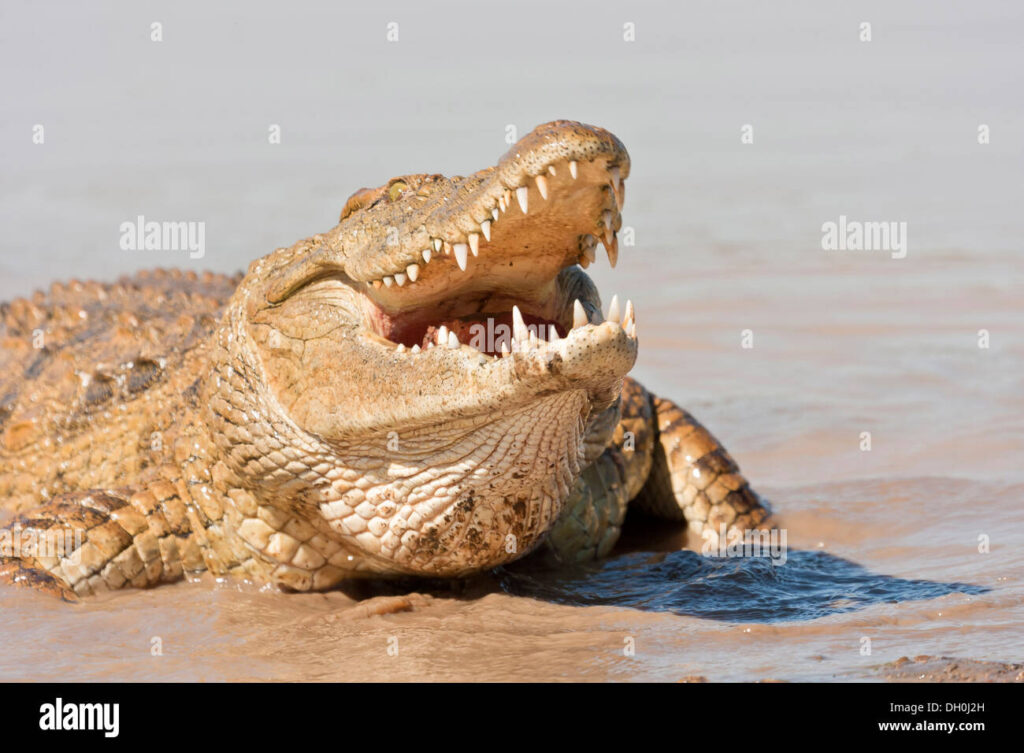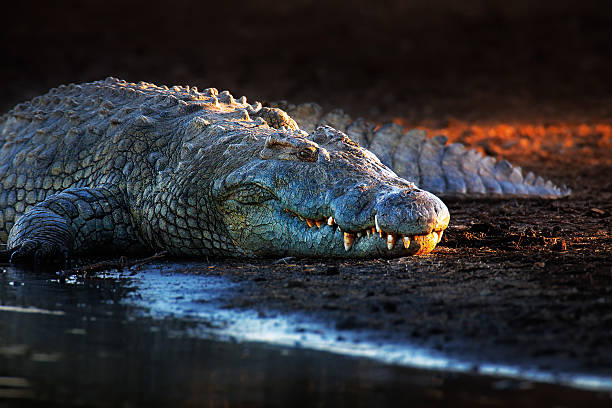Nile Crocodile Habitat Destruction
Introduction
Nile Crocodile Habitat Destruction The Nile crocodile (Crocodylus niloticus) is one of the most iconic reptile species in Africa, renowned for its powerful presence and critical role as an apex predator. Found in a variety of freshwater habitats ranging from rivers and lakes to swamps and marshes, the Nile crocodile plays a pivotal role in maintaining the ecological balance of these ecosystems. However, habitat destruction poses a severe threat to the survival of this species, endangering not only the crocodiles themselves but also the health of the ecosystems they inhabit. This article aims to delve into the complexities of Nile crocodile habitat destruction, examining its causes, impacts, and potential conservation strategies to protect this ancient species.
Nile Crocodile Habitat Characteristics
Nile crocodiles are highly adaptable creatures, inhabiting diverse environments across sub-Saharan Africa. Their preferred habitats include wetlands, rivers, lakes, marshes, and estuarine environments, where they rely on stable water levels and access to prey. They are known for their ability to travel significant distances in search of suitable environments, particularly during the dry season when water bodies may shrink or disappear entirely.

Seasonal movements are a crucial aspect of Nile crocodile behavior, as they seek out optimal conditions for breeding and nesting. Female crocodiles require specific nesting sites with appropriate soil composition and proximity to water, which ensures the survival of their eggs and hatchlings. Alterations to these habitats, such as changes in water levels due to human activities or climate change, can disrupt these natural patterns and severely affect crocodile populations.
Causes of Habitat Destruction
Habitat destruction is a multifaceted problem driven by a combination of human activities and environmental changes. The primary contributors include urban development, water management projects, industrial activities, climate change, and depletion of prey species.
Human Activities
- Urban Development
As human populations expand, there is an increasing demand for land for housing, agriculture, and infrastructure development. Wetlands and riverine areas, which are prime habitats for Nile crocodiles, are often converted into agricultural fields or urbanized landscapes. Such developments disrupt the natural flow of rivers and lead to the loss of crucial habitats that support the lifecycle of Nile crocodiles. - Dams and Water Management Projects
Dams and water diversion projects have a profound impact on the natural hydrology of river systems. They alter water flow, disrupt sediment deposition, and fragment habitats. The construction of dams can prevent Nile crocodiles from accessing traditional breeding sites, and changes in water quality can affect their health and reproductive success. - Mining and Industrial Activities
Mining and other industrial activities often lead to pollution and habitat fragmentation. Chemicals and waste products released into rivers and wetlands can degrade water quality, making it unsuitable for both crocodiles and their prey. Habitat fragmentation caused by roads and infrastructure associated with mining activities further isolates crocodile populations, reducing genetic diversity and increasing vulnerability to other threats.
Climate Change Effects
Climate change exacerbates existing threats by altering precipitation patterns and water temperatures. Prolonged droughts and erratic rainfall patterns can cause significant fluctuations in water levels, which affect the availability of nesting sites and food resources. Higher temperatures can also impact the sex ratio of hatchlings, as the temperature at which eggs incubate determines the gender of the offspring.
Overfishing and Depletion of Prey Species
Overfishing in rivers and lakes depletes the primary food sources of Nile crocodiles, leading to malnutrition and reduced survival rates. This issue is particularly severe in regions where fishing is unregulated, and local communities rely heavily on aquatic resources for their livelihoods. As prey species decline, crocodiles may be forced to venture closer to human settlements in search of food, increasing the likelihood of human-crocodile conflict.
Impact of Habitat Destruction on Nile Crocodiles

The destruction of habitats has led to a significant decline in Nile crocodile populations across their range. The impacts of habitat loss are multifaceted, affecting not only the number of individuals but also their behavior, health, and interactions with humans.
Decline in Population Numbers
Habitat loss reduces the availability of suitable nesting sites, leading to a decline in reproductive success. Without safe nesting areas, eggs are more vulnerable to predation and environmental factors, such as flooding or excessive heat. This, coupled with habitat fragmentation, results in isolated populations that have limited access to mates and are at greater risk of local extinction.
Increased Human-Wildlife Conflict
As natural habitats are destroyed or degraded, Nile crocodiles are often forced to move closer to human settlements. This proximity increases the potential for conflict, as crocodiles may prey on livestock or come into contact with people. In many cases, this results in retaliatory killings or the capture of crocodiles, further threatening their populations.
Changes in Behavior and Physiology
Habitat destruction can also lead to changes in the behavior and physiology of Nile crocodiles. For example, individuals in degraded habitats may alter their hunting patterns or diet, resorting to less optimal food sources. This can impact their growth, reproductive success, and overall health. In some cases, increased stress levels can make crocodiles more aggressive or less likely to reproduce.
Conservation Efforts and Strategies
Conservation strategies aimed at mitigating the impact of habitat destruction on Nile crocodiles are multifaceted, involving habitat protection, sustainable water management, community engagement, and research initiatives.
Protection of Critical Habitats

Establishing protected areas and reserves is one of the most effective ways to conserve Nile crocodile populations. Protected areas provide safe havens where crocodiles can breed, feed, and thrive without the threat of habitat destruction. Rehabilitation of degraded habitats, such as reforestation of riparian zones and restoration of wetlands, can also enhance habitat quality and connectivity.
Sustainable Water Management Policies
Effective water management is crucial for maintaining healthy Nile crocodile habitats. Policies that regulate water usage for agriculture, industry, and urban development can help ensure that water levels remain stable and that natural flow regimes are preserved. This, in turn, supports the ecological processes that sustain crocodile populations.
Community Engagement and Awareness Programs
Community engagement is essential for the success of conservation initiatives. Educating local communities about the ecological importance of Nile crocodiles and implementing programs to reduce human-crocodile conflict can foster coexistence and reduce retaliatory killings. Community-based conservation projects, where local people are actively involved in monitoring and protecting crocodile habitats, have shown promising results in several regions.

Continued research and monitoring are vital for understanding the status of Nile crocodile populations and their habitats. Research efforts can focus on tracking population trends, assessing habitat quality, and identifying new threats. Data collected from these programs can inform conservation policies and management decisions, ensuring that strategies are based on the best available science.
Challenges and Future Directions
Despite the progress made in Nile crocodile conservation, several challenges remain. Balancing development needs with conservation priorities is one of the most significant hurdles, as infrastructure projects and agricultural expansion continue to encroach on critical habitats. Ensuring compliance with existing laws and policies is another challenge, as enforcement is often weak in remote areas.

Addressing these challenges will require greater collaboration between governments, conservation organizations, and local communities. International cooperation is also essential, as Nile crocodile populations span multiple countries and cross-border conservation initiatives can be highly effective.
Conclusion
Habitat destruction poses a serious threat to the survival of Nile crocodiles, with far-reaching impacts on their populations, behavior, and interactions with humans. Effective conservation strategies must address the root causes of habitat loss, while also promoting coexistence between humans and crocodiles. By protecting critical habitats, implementing sustainable water management practices, and engaging local communities, it is possible to secure a future for this iconic species. Continued research and international collaboration will be key to overcoming the challenges ahead and ensuring that Nile crocodiles continue to thrive in their natural habitats
FAQs
What types of habitats do Nile crocodiles prefer?
Nile crocodiles are highly adaptable and thrive in a variety of freshwater habitats, including rivers, lakes, wetlands, marshes, and estuarine environments. They favor areas with stable water levels and abundant prey, such as fish and small mammals. During the dry season, they may move between water bodies in search of suitable habitats.
What are the main causes of Nile crocodile habitat destruction?
The primary causes of habitat destruction include urban development, dams and water management projects, mining and industrial activities, climate change, and overfishing. These factors lead to the loss and degradation of critical habitats, disrupt natural water flow, and reduce prey availability.
How does habitat destruction affect Nile crocodile populations?
Habitat destruction impacts Nile crocodiles in several ways, including reduced access to breeding sites, lower reproductive success, increased mortality rates, and changes in behavior and diet. It also leads to population fragmentation, which can reduce genetic diversity and make populations more vulnerable to other threats.
Why do Nile crocodiles come into conflict with humans?
As natural habitats are destroyed or altered, Nile crocodiles are often forced to move closer to human settlements in search of food or suitable living conditions. This proximity increases the likelihood of encounters, which can result in attacks on livestock or, in rare cases, humans. Human-crocodile conflict can lead to retaliatory killings or the removal of crocodiles from the wild.
What role do Nile crocodiles play in their ecosystems?
Nile crocodiles are apex predators and play a crucial role in maintaining the health and balance of their ecosystems. By controlling fish and other prey populations, they help prevent overpopulation and ensure the stability of aquatic ecosystems. Their presence also supports biodiversity by creating microhabitats through their nesting and basking behaviors.
How does climate change contribute to habitat loss for Nile crocodiles?
Climate change can alter precipitation patterns, leading to prolonged droughts or extreme flooding events. These changes disrupt the natural water levels that crocodiles depend on for nesting and feeding. Additionally, increased water temperatures can impact the sex ratio of hatchlings, as the temperature at which eggs are incubated determines the gender of the offspring.
What are the current conservation efforts for Nile crocodiles?
Conservation efforts include the establishment of protected areas, rehabilitation of degraded habitats, sustainable water management policies, and community engagement initiatives. Research and monitoring programs also play a vital role in tracking population trends and assessing habitat quality to inform conservation strategies.
How can local communities contribute to Nile crocodile conservation?
Local communities can contribute by participating in community-based conservation projects, helping monitor crocodile populations, and implementing practices that reduce human-crocodile conflict. Educational programs that raise awareness about the importance of Nile crocodiles and promote coexistence are also essential for long-term conservation success.
Are there international efforts to protect Nile crocodiles?
Yes, there are international efforts to protect Nile crocodiles, particularly through cross-border conservation initiatives and collaborations between governments, NGOs, and research institutions. Nile crocodiles are listed under CITES (the Convention on International Trade in Endangered Species of Wild Fauna and Flora), which regulates international trade to ensure their survival in the wild.
What can be done to reduce the impact of habitat destruction on Nile crocodiles?
Reducing the impact of habitat destruction requires a multifaceted approach, including stricter enforcement of environmental regulations, sustainable land and water management practices, and the protection and restoration of critical habitats. Encouraging responsible development practices and promoting community engagement in conservation efforts are also key strategies to mitigate habitat loss.
Are Nile crocodile populations stable, or are they declining?
Nile crocodile populations are stable in some regions but declining in others due to habitat destruction, human-wildlife conflict, and illegal hunting. Effective conservation strategies are needed to ensure the long-term survival of populations that are currently facing significant threats.
How does habitat fragmentation affect Nile crocodiles?
Habitat fragmentation isolates crocodile populations, reducing their access to mates and increasing inbreeding, which can lower genetic diversity. It also forces crocodiles to cross dangerous areas, such as roads or human settlements, increasing the risk of mortality from human activities.
What are the long-term consequences of Nile crocodile habitat destruction?
Long-term consequences include potential local extinctions, loss of biodiversity, and disruption of ecosystem functions. If key habitats continue to be destroyed, Nile crocodiles may become confined to smaller, less suitable areas, leading to further declines in population numbers and a reduced ability to recover from other threats.
How can I help support Nile crocodile conservation?
You can support Nile crocodile conservation by donating to reputable wildlife organizations, supporting community-based conservation projects, spreading awareness about the importance of protecting their habitats, and advocating for policies that protect critical ecosystems. Reducing your environmental footprint and promoting sustainable development practices can also indirectly benefit crocodile habitats.
What is the future outlook for Nile crocodile populations if habitat destruction continues?
If habitat destruction continues unabated, Nile crocodile populations could face severe declines, particularly in areas where habitat loss is most pronounced. However, with effective conservation measures and increased protection of critical habitats, it is possible to stabilize and even increase their populations over time..
